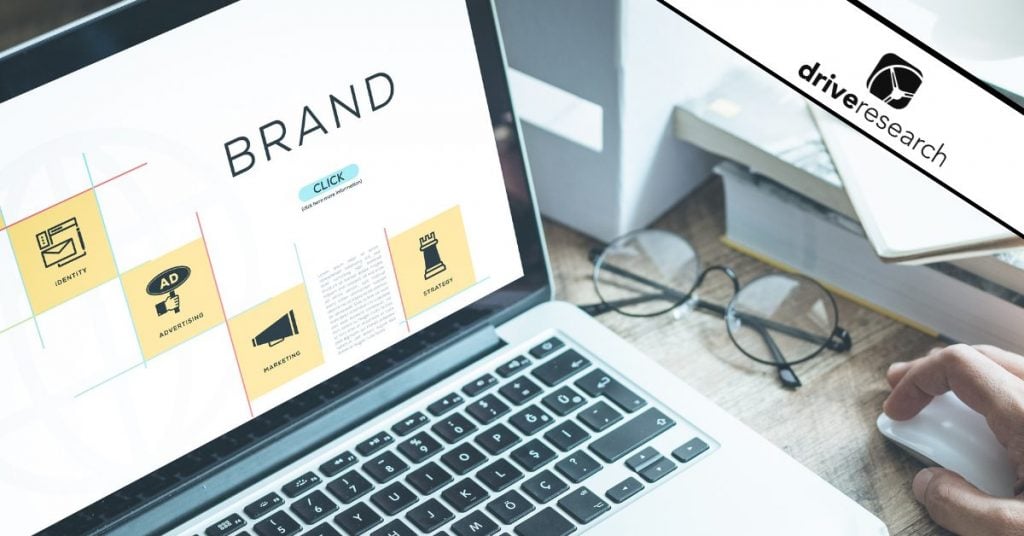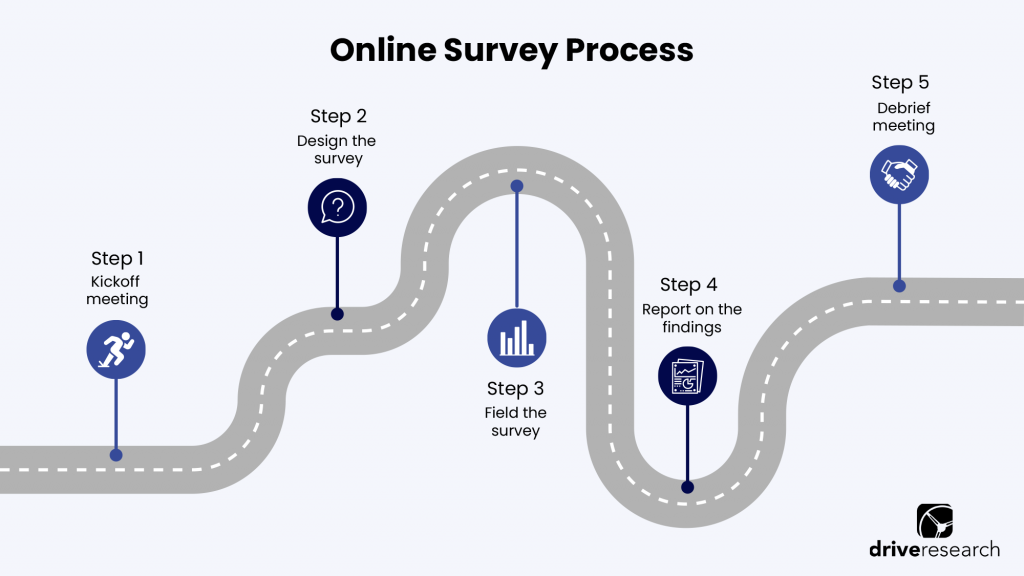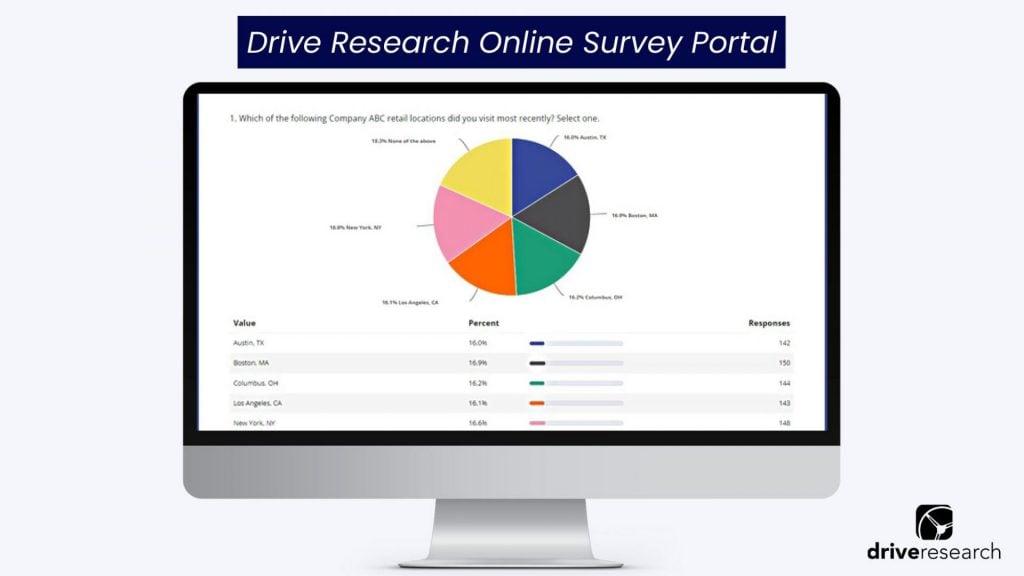
Brand recognition isn’t built in a day. It can take a lot of time, marketing dollars, and strategic decision-making to become a household name. It’s important to know where in the process companies are with their brand.
It’s why many organizations conduct brand awareness surveys.
Brand surveys effectively track a company’s progress to identify what’s working and what’s a waste of money.
In this article, we’ll share an in-depth overview of brand awareness surveys including how to conduct them, questions to include, and a real-world example of brand surveys in action.
Brand Awareness Surveys: Our Definition
A brand awareness survey is a type of market research study that measures and assesses awareness, perception, and brand equity.
Brand surveys are also referred to as image and awareness (I&A) surveys.
The two follow similar objectives and processes, but I&A studies is a term that may be more familiar in some circles.
Known or established brands often use these types of online surveys to help make data-driven decisions on their brand strategy and marketing efforts.
And with 46% of customers more likely to buy from brands they are familiar with, taking the time to measure awareness over time is worth it.
Aided Awareness vs. Unaided Awareness
Whether you are conducting a survey to measure awareness of a brand, product, service, or marketing, there are two types of metrics to understand.
Our online survey company measures both aided and unaided awareness for clients because each metric can tell a lot about brand popularity.
For a more in-depth explanation, I recommend reading our blog post, What is Unaided and Aided Awareness in Market Research?
Aided awareness
Aided awareness is the number of people who are aware of your brand when asked or shown visuals.
For instance, here is an example survey question measuring aided awareness of a soda brand.
Respondents select what soda brand they recognize from the list provided.
Another way to measure aided awareness in a survey is to ask, “Are you aware of Pepsi?” with yes or no answer options.
Unaided awareness
Unaided awareness is the number of people who are aware of your brand without being asked or shown visuals.
In comparison, here is an example survey question measuring unaided awareness of a soda brand.
To calculate a total brand awareness figure, simply add the unaided and aided awareness percentages together.
For example, if 73% of respondents are aware of Pepsi aided and another 22% are aware of Pepsi aided, the total awareness of Pepsi is 95%.
Conducting a Survey on Brand Awareness
While there are many different types of market research, online surveys are a great methodology for brands looking for cost-effective and quality results.
Plus, fieldwork for online brand awareness surveys can often be completed in as little as two days.
Below is the step-by-step process our online survey company follows when measuring brand awareness for various types of organizations.

Step 1. Define Your Objects and Target Audience
Before conducting a brand awareness survey, meet with internal stakeholders to discuss your goals and objectives for the project.
It is also a great time to decide the criteria of who you want to collect feedback (gender, age, income, location, etc.)
For instance, some brands may want to survey the general population, while others want to survey those similar to their target consumers.
It is important to only reach target respondents to obtain the most accurate possible measurement of brand awareness in the market.
A next step is to contact a market research company, like Drive Research. Or, if executing the study in-house use the steps below.
Step 2. Kickoff Meeting
Once you have expressed interest in sponsoring a brand awareness survey and partnered with a market research firm, the first official step is usually a kickoff meeting.
This step is focused on the following details:
- Meeting your dedicated project team
- Defining the objectives of the study
- Mapping out the project timeline
- Understanding roles and responsibilities
- Answering any questions or concerns
The conversations had in the kickoff meeting are critical in each stage moving forward.
Step 3. Survey Draft
Next, our market research team drafts the brand awareness survey questions in a Google doc.
Doing so allows us to collaborate with our clients to assure both parties are happy with the end result.
If conducting the study in-house, here are a few tips to follow when writing the survey for increased response rates.
Keep it short.
Aim to keep your brand awareness survey to 25 questions.
Anything longer, and respondents will start to drop off or provide low-quality answers.
what questions are must-haves and what are nice-to-haves. This can help weed out any unnecessary questions that make the survey 10 minutes long.
Be conscious of the respondent experience.
In addition to short surveys, switching up the question types will keep respondents more engaged and focused from start to finish.
Here are 36 types of questions from our market research company.
Offer an incentive.
Whether it be a pay-per-response model or a raffle, provide some type of reward for respondents.
It is a surefire way to get more responses.
After your company is happy with the questionnaire, our market research firm will program it into an online survey format and administer quality assurance testing.
Step 4. Survey Fieldwork
The next step in conducting brand awareness surveys is fieldwork.
The survey is sent to the target audience defined in the initial stages of the project. This is a critical step, as distributing the survey to the wrong audience will render the awareness data useless.
A common best practice for brand awareness surveys is to break up fieldwork into two stages.
- Soft launch: Send the survey to a small sample of people. Review answers to verify the survey is working as intended.
- Full launch: Send the survey to the remaining sample once everything checks out in the soft launch phase.
As soon as fieldwork beings, Drive Research provides clients with a link to a live portal.
Here is where you can view responses to your brand awareness survey in real time.

Use this interactive link to preview our client survey portal
Our market research firm will also continue to run quality checks to ensure the integrity of the survey data and remove bad cases.
Step 5. Survey Analysis
Finally, the analysis and reporting stage begins in which insights and recommendations are assembled for your company.
With a brand study, your company would likely receive a number of materials from a market research company.
The featured deliverable would be a comprehensive market research report.
This brand awareness survey report should include:
- Background and methodology
- Executive summary of findings
- Infographic
- Actionable recommendations
- A detailed breakdown of data from each question in the survey
Also included should be a raw data file with all survey responses. This allows your company to dig into the details or even conduct further analysis.
You can expect a debrief of the results after the report is delivered.
20+ Example Brand Awareness Survey Questions
There are a ton of sample questions readily available for you to use, however it’s important to remember that they should be unique to your brand. Here’s some sample questions that you can use but remember to change them up to fit your goals and company.
For example, say you are mainly focused on measuring awareness of a recent marketing and advertising campaign.
Then, a majority of your brand awareness questionnaire should center around if, where, and when people saw these ads.
To help get you started, below are 20+ brand awareness survey questions based on different objectives and goals.
Questions about brand awareness
- When you think of [Industry] brands, what comes to mind first? (Unaided Awareness)
- Which of the following brands are you aware of? (Aided Awareness)
- What brand is the most recognizable in [Product category]?
- Which of the following brands make you most happy?
- If [Your Brand Name] was a person, how would you describe that person?
- When thinking of buying a [Product/service], which product comes to mind as your top choice?
- How familiar are you with [Your Brand Name]’s products and services?
Questions about branding and ‘how did you hear about us’ options
- What characteristics or values of our brand make it recognizable?
- What makes our brand more recognizable than other competing brands?
- Have you seen [Your Brand Name]’s advertisements in the past three months?
- Where did you see the advertisements?
- How did you find out about [Your Brand Name]?
- Which of the following messages do you associate with [Your Brand Name]?
- What stood out most from the ads you have seen?
Questions about brand perception
- What is your perception of each of the following brands?
- When you see or hear [Your Brand Name], what is the first word or phrase that comes to mind?
- Which of the following words best describe how you feel about [Your Brand Name]?
- How has your perception of our brand changed over the last few months?
Questions about purchasing and usage
- Do you currently use any products or services from any of these brands?
- Which of the following brands have you used in the past year?
- When was the last time you used a [Product/service]?
- Which brands do you purchase [Product/service] from?
- Considering [Product/service], which brands would you consider purchasing from next?
- When it comes to buying [Product/service], are you the main decision maker?
Brand Awareness Survey Case Study
Drive Research often conducts brand awareness surveys with our clients.
In this section, we will share a real-world example of this methodology in action.
Client Objectives
A marketing firm in Illinois contacted our market research company on behalf of a consumer packaged goods (CPG) client.
The marketing firm was in the process of creating an advertising campaign for the CPG brand.
The goal of the advertising campaign would be to grow brand awareness for their client however, it was unclear how the consumer packaged goods brand was already perceived by their target market.
In other words, to grow awareness for their client, the marketing firm wanted to understand the starting point for how notable the brand already was.
Furthermore, the main objectives of the market research study would be to measure:
- Unaided and aided awareness
- Perception of the brand
- Competitive awareness and perceptions
- The decision-making process of the buyer
The Challenge
It can be challenging to show the true success of an advertising campaign, especially when the goal is to grow brand awareness.
The common analytics of clicks and impressions mean very little in this regard. In fact, these statistics often do not tell the full story.
For example, perhaps a digital marketing campaign resulted in 167 clicks, but 0 online purchases.
This can be a challenging conversation to have with a client.
But what if you could say brand awareness grew by 64% because of the marketing campaign?
This is a stat not available without conducting market research.
The Solution: Brand Awareness Surveys
To provide this type of insight for the marketing firm, our market research company recommended running a brand awareness survey.
This study involved surveying a target audience before a marketing campaign to measure…
- Awareness
- Perception
- Likes/dislikes
And other marketing KPIs.
The first survey often serves as a benchmark. Then, when the marketing campaign is complete, the second wave of a brand awareness survey is conducted.
Some brands may even choose to conduct three surveys: one before the marketing campaign, one during, and one after.
Our Approach to Measuring Brand Awareness
To address the objectives at hand, Drive Research recommended using an online survey to collect feedback.
The market research was administered using consumer email databases in the United States.
The criteria for the brand awareness survey included grocery shoppers who are 18 or older.
The questionnaire on branding included the following questions:
- Which of the following types of products do you regularly purchase on your trips to the grocery store? Select all that apply.
- Which of these cheese products do you regularly purchase? Select all that apply.
- How many packages of string cheese/cheese sticks have you purchased in the past 3 months?
- What is the first brand of string cheese/cheese sticks to come to mind?
- Which of the following brands of string cheese/cheese sticks are you aware of? Select all that apply.
- What is your perception of the following brands?
- Which of the following type(s) of product(s) do you most associate with [CLIENT NAME]?
- What factors are most important to you when purchasing string cheese/cheese sticks?
- Which of the following brands of string cheese/cheese sticks have you purchased in the past 3 months? Select all that apply.
Other survey details
The brand awareness survey took an average of 7 minutes to complete and included 24 questions. The survey received 1,000 responses. Fieldwork began on September 18 and lasted until September 25, 2020.
With a probabilistic sample, 1,000 responses at the 95% confidence level offered a 3.1% margin of error.
In other words, if the survey were conducted with another random pool of 1,000 consumers across the country, results would yield within +3.1% or -3.1% of the reports’ stated totals.
Brand Awareness Survey Results
As mentioned previously, the results will serve as a measurement and market research benchmark for an upcoming advertising campaign.
It is expected the study will be revisited post-campaign to understand how key performance indicators, such as brand awareness and perception, have shifted.
The marketing firm and CPG brand received a topline summary report from our market research firm.
The topline market research report included:
- Background and methodology
- Participant profiles
- An executive summary of key findings
This deliverable provides a bullet-point style report touching on the critical insights from the market research study.
Other deliverables include a brand tracker scorecard and an Excel banner file with crosstabs.
Final Thoughts
It is every organization’s dream to reach the threshold where it starts becoming top-of-mind among its target audience.
Brand awareness surveys are the greatest tool for understanding how close you are to reaching that goal.
That’s because this type of market research provides a clear measurement of what marketing strategies are working and what are not.
Marketers don’t have to rely on best guesses and assumptions but on fact-based evidence from target consumers on what actions to take to improve awareness, perception, and other critical KPIs.
Contact Our Brand Awareness Survey Company
Drive Research is a national market research company specializing in brand awareness surveys.
Our market research team partners with organizations across the country to effectively measure brand awareness, perception, satisfaction, loyalty, and other drivers of a business’s success.
Contact Drive Research by filling out the form below or emailing [email protected].



